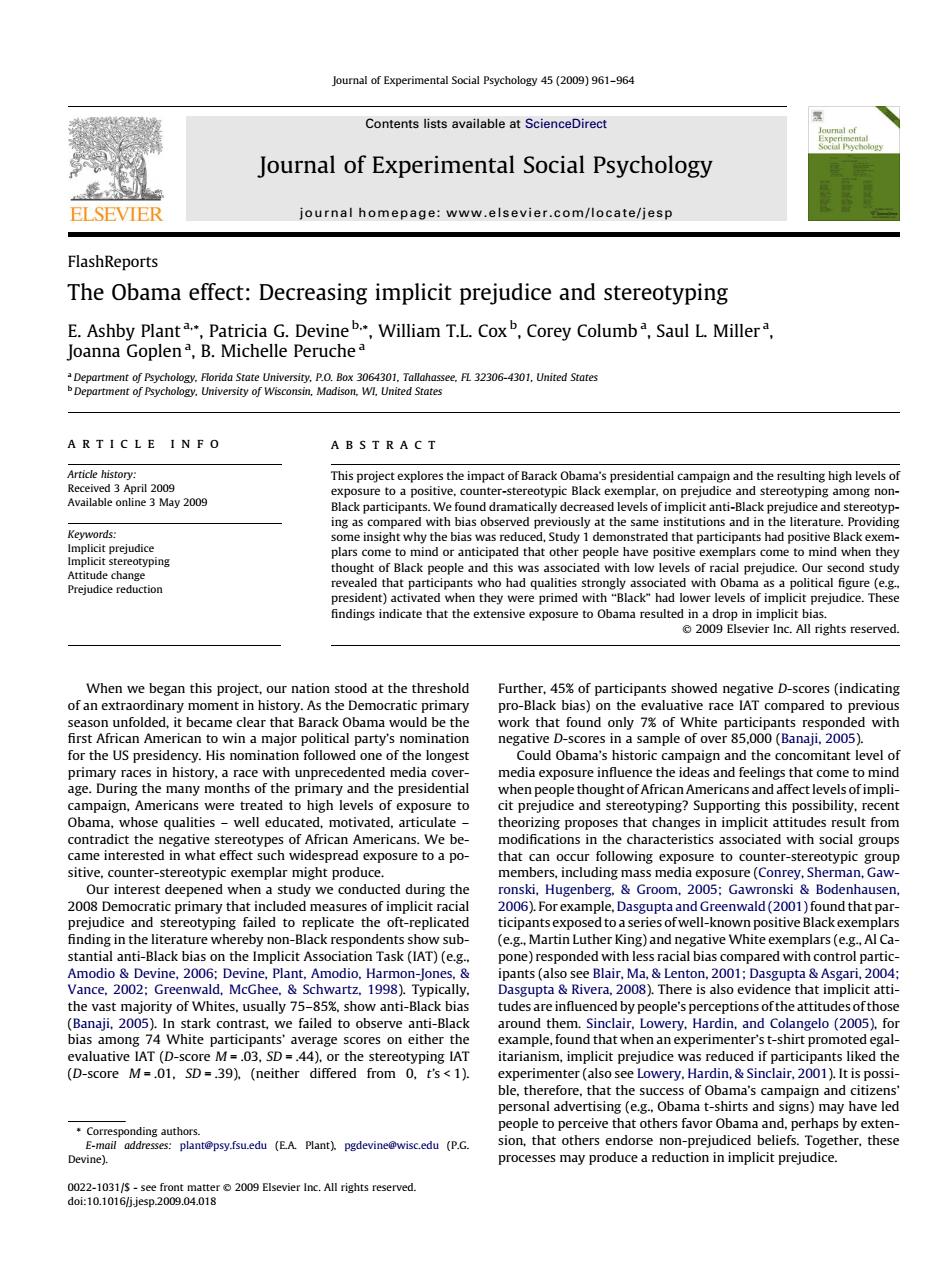正在加载图片...

Contents lists available at ScienceDirect Journal of Experimental Social Psychology FL SEVIER journal homepage:www.elsevier.com/locate/jesp FlashReports The Obama effect:Decreasing implicit prejudice and stereotyping E.Ashby PlantPatricia G.DevineWilliam T.L.CoxCorey ColumbSaul L Miller Joanna Goplen,B.Michelle Peruche ARTICLE INFO ABSTRACT Ntceton This mpact of Barack a lting high k Black partic ts We fo ddramatic licit anti-Bl. udice and st ht whyo Study 1 de ho had qualities st ow l t preju When we began this project.our nation stood at the threshold art aiand the level of ing?S sitive.counter-stereotypi exemplar might produce. and Greenwald (2001)found that par yping failed【 n-Back cate th ee.Sc wartz,199)Typically gupta&River 0) nt-Back mpnLwery.and o (2005).fo pants lked the It is po hirts and gns)may have le ay pr in imp t preFlashReports The Obama effect: Decreasing implicit prejudice and stereotyping E. Ashby Plant a,*, Patricia G. Devine b,*, William T.L. Cox b , Corey Columb a , Saul L. Miller a , Joanna Goplen a , B. Michelle Peruche a aDepartment of Psychology, Florida State University, P.O. Box 3064301, Tallahassee, FL 32306-4301, United States bDepartment of Psychology, University of Wisconsin, Madison, WI, United States article info Article history: Received 3 April 2009 Available online 3 May 2009 Keywords: Implicit prejudice Implicit stereotyping Attitude change Prejudice reduction abstract This project explores the impact of Barack Obama’s presidential campaign and the resulting high levels of exposure to a positive, counter-stereotypic Black exemplar, on prejudice and stereotyping among nonBlack participants. We found dramatically decreased levels of implicit anti-Black prejudice and stereotyping as compared with bias observed previously at the same institutions and in the literature. Providing some insight why the bias was reduced, Study 1 demonstrated that participants had positive Black exemplars come to mind or anticipated that other people have positive exemplars come to mind when they thought of Black people and this was associated with low levels of racial prejudice. Our second study revealed that participants who had qualities strongly associated with Obama as a political figure (e.g., president) activated when they were primed with ‘‘Black” had lower levels of implicit prejudice. These findings indicate that the extensive exposure to Obama resulted in a drop in implicit bias. 2009 Elsevier Inc. All rights reserved. When we began this project, our nation stood at the threshold of an extraordinary moment in history. As the Democratic primary season unfolded, it became clear that Barack Obama would be the first African American to win a major political party’s nomination for the US presidency. His nomination followed one of the longest primary races in history, a race with unprecedented media coverage. During the many months of the primary and the presidential campaign, Americans were treated to high levels of exposure to Obama, whose qualities – well educated, motivated, articulate – contradict the negative stereotypes of African Americans. We became interested in what effect such widespread exposure to a positive, counter-stereotypic exemplar might produce. Our interest deepened when a study we conducted during the 2008 Democratic primary that included measures of implicit racial prejudice and stereotyping failed to replicate the oft-replicated finding in the literature whereby non-Black respondents show substantial anti-Black bias on the Implicit Association Task (IAT) (e.g., Amodio & Devine, 2006; Devine, Plant, Amodio, Harmon-Jones, & Vance, 2002; Greenwald, McGhee, & Schwartz, 1998). Typically, the vast majority of Whites, usually 75–85%, show anti-Black bias (Banaji, 2005). In stark contrast, we failed to observe anti-Black bias among 74 White participants’ average scores on either the evaluative IAT (D-score M = .03, SD = .44), or the stereotyping IAT (D-score M = .01, SD = .39), (neither differed from 0, t’s < 1). Further, 45% of participants showed negative D-scores (indicating pro-Black bias) on the evaluative race IAT compared to previous work that found only 7% of White participants responded with negative D-scores in a sample of over 85,000 (Banaji, 2005). Could Obama’s historic campaign and the concomitant level of media exposure influence the ideas and feelings that come to mind when people thought of African Americans and affect levels of implicit prejudice and stereotyping? Supporting this possibility, recent theorizing proposes that changes in implicit attitudes result from modifications in the characteristics associated with social groups that can occur following exposure to counter-stereotypic group members, including mass media exposure (Conrey, Sherman, Gawronski, Hugenberg, & Groom, 2005; Gawronski & Bodenhausen, 2006). For example, Dasgupta and Greenwald (2001)found that participants exposed to a series of well-known positive Black exemplars (e.g., Martin Luther King) and negative White exemplars (e.g., Al Capone) responded with less racial bias compared with control participants (also see Blair, Ma, & Lenton, 2001; Dasgupta & Asgari, 2004; Dasgupta & Rivera, 2008). There is also evidence that implicit attitudes are influenced by people’s perceptions of the attitudes of those around them. Sinclair, Lowery, Hardin, and Colangelo (2005), for example, found that when an experimenter’s t-shirt promoted egalitarianism, implicit prejudice was reduced if participants liked the experimenter (also see Lowery, Hardin, & Sinclair, 2001). It is possible, therefore, that the success of Obama’s campaign and citizens’ personal advertising (e.g., Obama t-shirts and signs) may have led people to perceive that others favor Obama and, perhaps by extension, that others endorse non-prejudiced beliefs. Together, these processes may produce a reduction in implicit prejudice. 0022-1031/$ - see front matter 2009 Elsevier Inc. All rights reserved. doi:10.1016/j.jesp.2009.04.018 * Corresponding authors. E-mail addresses: plant@psy.fsu.edu (E.A. Plant), pgdevine@wisc.edu (P.G. Devine). Journal of Experimental Social Psychology 45 (2009) 961–964 Contents lists available at ScienceDirect Journal of Experimental Social Psychology journal homepage: www.elsevier.com/locate/jesp��